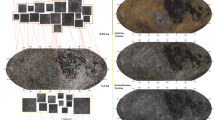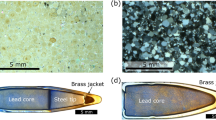Abstract
IN 1965, Baldwin1 investigated the relationship between diameter and depths for some lunar craters from Ranger VII photographs. He used the values from the Ranger Lunar Charts (RLC) published by the Aeronautical Chart and Information Center. Baldwin found that the diameter–depth relationship for these craters may be represented by the equation  where D and d are the logarithmic diameter and depth of craters in feet.
where D and d are the logarithmic diameter and depth of craters in feet.
This is a preview of subscription content, access via your institution
Access options
Subscribe to this journal
Receive 51 print issues and online access
$199.00 per year
only $3.90 per issue
Buy this article
- Purchase on SpringerLink
- Instant access to full article PDF
Prices may be subject to local taxes which are calculated during checkout
Similar content being viewed by others
References
Baldwin, R. B., Astron. J., 70, 545 (1965).
“Ranger” VII Photographs of the Moon, Part II, Camera “B” Series (Photographic Edition) (Jet Prop. Lab., Calif. Inst. of Technology, 1964). “Ranger” VIII Photographs of the Moon (Photographic Edition, Camera “B”) (1965). “Ranger” IX Photographs of the Moon (Photographic Edition, Camera “B”) (1965).
Author information
Authors and Affiliations
Rights and permissions
About this article
Cite this article
BOUŠKA, J. Crater Diameter–Depth Relationship from Ranger Lunar Photographs. Nature 213, 166 (1967). https://doi.org/10.1038/213166a0
Received:
Issue date:
DOI: https://doi.org/10.1038/213166a0
This article is cited by
-
Recent observations of the Moon by spacecraft
Space Science Reviews (1969)



